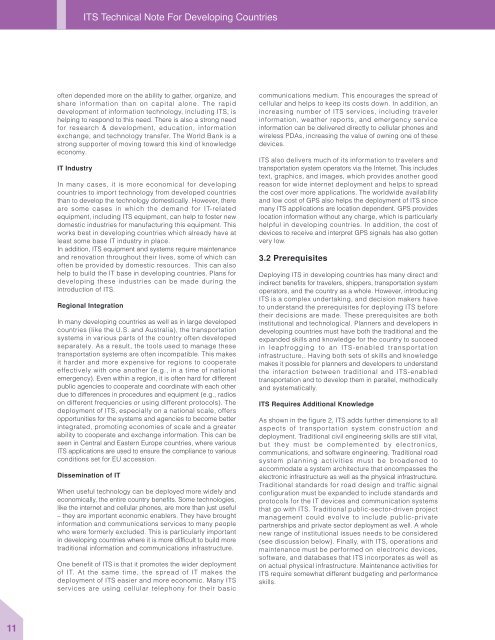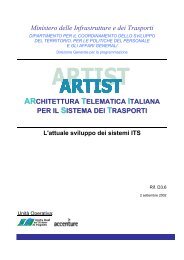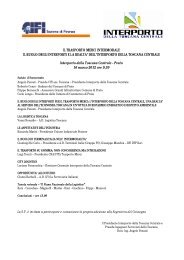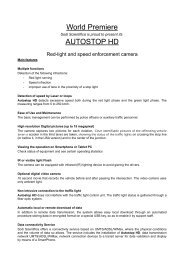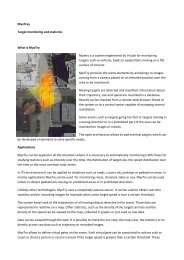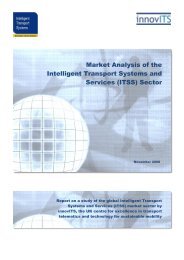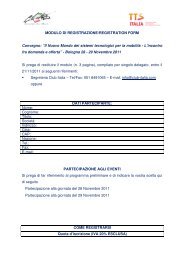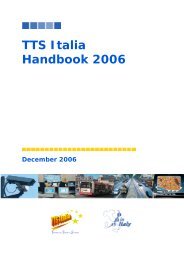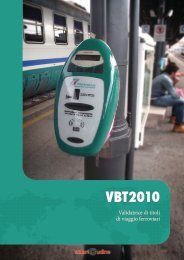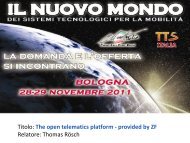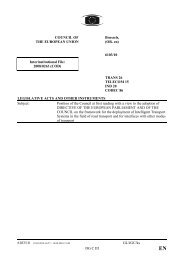ITS for Developing Countries ITS for Developing Countries - TTS Italia
ITS for Developing Countries ITS for Developing Countries - TTS Italia
ITS for Developing Countries ITS for Developing Countries - TTS Italia
Create successful ePaper yourself
Turn your PDF publications into a flip-book with our unique Google optimized e-Paper software.
<strong>ITS</strong> Technical Note For <strong>Developing</strong> <strong>Countries</strong><br />
often depended more on the ability to gather, organize, and<br />
share in<strong>for</strong>mation than on capital alone. The rapid<br />
development of in<strong>for</strong>mation technology, including <strong>ITS</strong>, is<br />
helping to respond to this need. There is also a strong need<br />
<strong>for</strong> research & development, education, in<strong>for</strong>mation<br />
exchange, and technology transfer. The World Bank is a<br />
strong supporter of moving toward this kind of knowledge<br />
economy.<br />
IT Industry<br />
In many cases, it is more economical <strong>for</strong> developing<br />
countries to import technology from developed countries<br />
than to develop the technology domestically. However, there<br />
are some cases in which the demand <strong>for</strong> IT-related<br />
equipment, including <strong>ITS</strong> equipment, can help to foster new<br />
domestic industries <strong>for</strong> manufacturing this equipment. This<br />
works best in developing countries which already have at<br />
least some base IT industry in place.<br />
In addition, <strong>ITS</strong> equipment and systems require maintenance<br />
and renovation throughout their lives, some of which can<br />
often be provided by domestic resources. This can also<br />
help to build the IT base in developing countries. Plans <strong>for</strong><br />
developing these industries can be made during the<br />
introduction of <strong>ITS</strong>.<br />
Regional Integration<br />
In many developing countries as well as in large developed<br />
countries (like the U.S. and Australia), the transportation<br />
systems in various parts of the country often developed<br />
separately. As a result, the tools used to manage these<br />
transportation systems are often incompatible. This makes<br />
it harder and more expensive <strong>for</strong> regions to cooperate<br />
effectively with one another (e.g., in a time of national<br />
emergency). Even within a region, it is often hard <strong>for</strong> different<br />
public agencies to cooperate and coordinate with each other<br />
due to differences in procedures and equipment (e.g., radios<br />
on different frequencies or using different protocols). The<br />
deployment of <strong>ITS</strong>, especially on a national scale, offers<br />
opportunities <strong>for</strong> the systems and agencies to become better<br />
integrated, promoting economies of scale and a greater<br />
ability to cooperate and exchange in<strong>for</strong>mation. This can be<br />
seen in Central and Eastern Europe countries, where various<br />
<strong>ITS</strong> applications are used to ensure the compliance to various<br />
conditions set <strong>for</strong> EU accession.<br />
Dissemination of IT<br />
When useful technology can be deployed more widely and<br />
economically, the entire country benefits. Some technologies,<br />
like the internet and cellular phones, are more than just useful<br />
– they are important economic enablers. They have brought<br />
in<strong>for</strong>mation and communications services to many people<br />
who were <strong>for</strong>merly excluded. This is particularly important<br />
in developing countries where it is more difficult to build more<br />
traditional in<strong>for</strong>mation and communications infrastructure.<br />
One benefit of <strong>ITS</strong> is that it promotes the wider deployment<br />
of IT. At the same time, the spread of IT makes the<br />
deployment of <strong>ITS</strong> easier and more economic. Many <strong>ITS</strong><br />
services are using cellular telephony <strong>for</strong> their basic<br />
communications medium. This encourages the spread of<br />
cellular and helps to keep its costs down. In addition, an<br />
increasing number of <strong>ITS</strong> services, including traveler<br />
in<strong>for</strong>mation, weather reports, and emergency service<br />
in<strong>for</strong>mation can be delivered directly to cellular phones and<br />
wireless PDAs, increasing the value of owning one of these<br />
devices.<br />
<strong>ITS</strong> also delivers much of its in<strong>for</strong>mation to travelers and<br />
transportation system operators via the Internet. This includes<br />
text, graphics, and images, which provides another good<br />
reason <strong>for</strong> wide internet deployment and helps to spread<br />
the cost over more applications. The worldwide availability<br />
and low cost of GPS also helps the deployment of <strong>ITS</strong> since<br />
many <strong>ITS</strong> applications are location dependent. GPS provides<br />
location in<strong>for</strong>mation without any charge, which is particularly<br />
helpful in developing countries. In addition, the cost of<br />
devices to receive and interpret GPS signals has also gotten<br />
very low.<br />
3.2 Prerequisites<br />
Deploying <strong>ITS</strong> in developing countries has many direct and<br />
indirect benefits <strong>for</strong> travelers, shippers, transportation system<br />
operators, and the country as a whole. However, introducing<br />
<strong>ITS</strong> is a complex undertaking, and decision makers have<br />
to understand the prerequisites <strong>for</strong> deploying <strong>ITS</strong> be<strong>for</strong>e<br />
their decisions are made. These prerequisites are both<br />
institutional and technological. Planners and developers in<br />
developing countries must have both the traditional and the<br />
expanded skills and knowledge <strong>for</strong> the country to succeed<br />
in leapfrogging to an <strong>ITS</strong>-enabled transpor tation<br />
infrastructure,. Having both sets of skills and knowledge<br />
makes it possible <strong>for</strong> planners and developers to understand<br />
the interaction between traditional and <strong>ITS</strong>-enabled<br />
transportation and to develop them in parallel, methodically<br />
and systematically.<br />
<strong>ITS</strong> Requires Additional Knowledge<br />
As shown in the figure 2, <strong>ITS</strong> adds further dimensions to all<br />
aspects of transportation system construction and<br />
deployment. Traditional civil engineering skills are still vital,<br />
but they must be complemented by electronics,<br />
communications, and software engineering. Traditional road<br />
system planning activities must be broadened to<br />
accommodate a system architecture that encompasses the<br />
electronic infrastructure as well as the physical infrastructure.<br />
Traditional standards <strong>for</strong> road design and traffic signal<br />
configuration must be expanded to include standards and<br />
protocols <strong>for</strong> the IT devices and communication systems<br />
that go with <strong>ITS</strong>. Traditional public-sector-driven project<br />
management could evolve to include public-private<br />
partnerships and private sector deployment as well. A whole<br />
new range of institutional issues needs to be considered<br />
(see discussion below). Finally, with <strong>ITS</strong>, operations and<br />
maintenance must be per<strong>for</strong>med on electronic devices,<br />
software, and databases that <strong>ITS</strong> incorporates as well as<br />
on actual physical infrastructure. Maintenance activities <strong>for</strong><br />
<strong>ITS</strong> require somewhat different budgeting and per<strong>for</strong>mance<br />
skills.<br />
11


